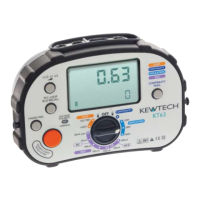kewtechcorp.com
19
kewtechcorp.com
High current test (Ze)
The high current should only be conducted with the distribution board test lead set ACC063
configured in 2 wire mode. Do not use this function with the KAMP12 mains lead or the
distribution lead set in 3-wire configuration.
Rotate the function selector to the HIGH position.
Connect the test lead probes to the circuit under test and press the test button.
The result will be shown in the primary display and the mains voltage will be shown in the
secondary display.
Press the PFC-LOOP button to show the PFC/PSC in the primary display and the impedance in
the secondary display area.
Note: The reading described here as PFC/PSC will be the prospective fault current for the circuit being
immediately tested. This is known as PSC in the case of a test between Live and Neutral or PEFC for a
test between Live and Earth conductors.
The 17
th
edition wiring regulations 2008: amendment 1 2011, call for an IPF value to be recorded, this is
the higher of the PSC and PEFC as described above.
Hands Free Loop testing
The hands free feature can be used in either No Trip or high current test modes.
To enable the hands free feature simply press the HANDS FREE button once, The
‘HANDSFREE’ annunciator will appear flashing on the LCD and will continue to do so until
cancelled by a further press of the HANDS FREE button or by changing the function selector
switch.
When the HANDSFREE annunciator is flashing all you need to do is connect the test lead to a
mains supply and the test will be automatically carried out.
RCD Test Function
Caution
Although fully protected against over voltage to 440V this tester should only be used on a
230V supply
The KT63 will test all of the most commonly encountered RCD’s of both standard (AC) type
and selective (ACS) type across the full range of tests required by the 17
th
Edition of the
wiring regulations.
Test requirements
Each RCD is tested to ensure that:
It operates with a maximum disconnection time of 300ms (AC type) when a fault at its i.
rated current is introduced. This is referred to as the x1 test.
It is not prone to ‘nuisance’ tripping and does not trip when a fault of half its rated i.
current is introduced. This is referred to as the x½ test
In the case of an RCD rated at 30mA there is an additional requirement that it ii.
operates with a maximum disconnection time of 40ms when a fault of five times its
rated current is introduced. This is referred to as the x5 test
For the reasons explained below all of the above tests have to be conducted at both 0° and
180° this means that four tests (or for 30mA RCD’s six tests) have to made for each RCD.
The user friendly design of the KT63 simplifies the test process by enabling you to do any of
these tests by making just two function selections.
Automatic test
For the most commonly encountered 30mA RCD the test process is even simpler. Just turn
the rotary selector to the ‘30mA AUTO’ setting and the KT63 will conduct all six required tests
at the single touch of a button.
Pass or Fail result
In addition to displaying the time taken for the RCD to trip the KT63 will also indicate whether
it has passed or failed the test requirements of the 17th edition.

